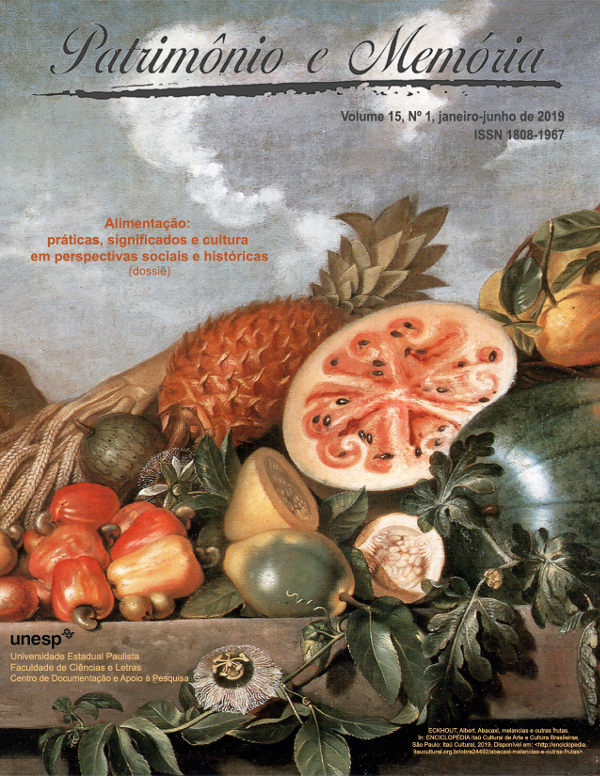From national heritage to world heritage
the making and the permanence of heritage's topos
DOI:
https://doi.org/10.5016/pem.v15i1.3266Keywords:
National Heritage, World Heritage, UnescoAbstract
This article performs a comparative analysis between the categories of national heritage and world heritage. For this purpose, it is a bibliographic review on this subject. The objective is to identify the rhetorical ordering principles that establish the legitimacy of heritage preservation - be it in the discourses of national heritage, elaborated by different nation-states, or in the discourse on world heritage, performed by Unesco. Based on this review, we highlight two arguments that work as real topos in both forms of patrimonial discourse: holistic rhetoric, as conceptualized by Joël Candau, and the rhetoric of loss, defined by José Reginaldo Gonçalves. When approaching the theoretical contributions of these two authors, we will point out that the arguments that underlie the discourses of the national heritage were adapted for the defense of the world heritage, thus indicating that the variations of the topos do not compromise the stability of its principles.
References
*Fontes textuais*
SOCIEDADE DAS NAÇÕES. Carta de Atenas. Atenas, 1931. Disponível em: <https://www.google.com.br/url?sa=t&rct=j&q=&esrc=s&source=web&cd=1&cad=rja&uact=8&ved=0ahUKEwjJ_re46v3VAhXFf5AKHbMnBM8QFggnMAA&url=http%3A%2F%2Fportal.iphan.gov.br%2Fuploads%2Fckfinder%2Farquivos%2FCarta%2520de%2520Atenas%25201931.pdf&usg=AFQjCNE4iu5tP0kSRGzEJ_foRMKUetwVMg>. Acesso em: jul. 2017.
UNESCO. Operational guidelines for the implementation of the World Heritage Convention. Intergovernmental Committee for the Protection of the World Cultural and Natural Heritage CC-77/CONF. 001/8 Rev. UNESCO, Paris. 20/10/1977. Disponível em: <http://whc.unesco.org/archive/out/opgu77. htm>. Acesso em: ago. 2016.
______ . Constitution of the United Nations Educational, Scientific and Cultural Organization. 1945. Disponível em: Acesso em: jul. 2017.
______ . Convention concerning the protection of the world cultural and natural heritage. 1972. Disponível em: <http://whc.unesco.org/en/conventiontext>. Acesso em: jul. 2017.
______ . Convention for the protection of cultural property in the event of armed conflict. 1954. Disponível em: <http://portal.unesco.org/culture/en/ev.php-URL_ID=35744andURL_DO=DO_TOPICandURL_SECTION=201.htm>. Acesso em: jul. 2017.
______ . The rescue of Nubian monuments and sites. 2010b. Disponível em: <http://whc.unesco.org/en/activities/173>. Acesso em: ago. 2017.
______ . Timeline: salvage of the monuments of Nubia. 2010a. Disponível em: <http://whc.unesco.org/uploads/activities/documents/activity-173-2.pdf>. Acesso em: ago. 2017.
*Bibliografia*
ANDERSON, B. Imagined communities: reflections on the origin and spread of nationalism. Londres: Verso, 1991.
BARTHES, Roland; BOUTTES, Jean-Louis. Lugares-comuns. In: Enciclopédia Einaudi. Lisboa: Imprensa Nacional; Casa da Moeda, 1985.
BABELON, J.P.; CHASTEL, André. La notion de patrimoine. Paris: L. Levi, 1994.
BATISSE, M.; BOLLA, G. The invention of world heritage. Les Cahiers d'Histoire, Paris, v. 1, n. 2, p. 9-95, 2005.
CANDAU, Joël. Memória e identidade. São Paulo: Contexto, 2011.
CHOAY, Françoise. A alegoria do patrimônio. São Paulo: Editora UNESP, 2001.
CLEERE, H. The concept of' outstanding universal value in the World Heritage Convention. Conservation and Management of Archaeological Sites, v. 1, n. 4, p. 227-233, 1996.
ELIAS, Norbert. A sociedade de corte. Rio de Janeiro: Zahar, 2001.
ERIKSEN, T. H. Between universalism and relativism: a critique of the UNESCO concept of culture. In: Human rights: an anthropological reader. Chichester: Blackwell Publishing, 2008, p. 356-371.
GONÇALVES, José Reginaldo Santos. A retórica da perda: os discursos do patrimônio cultural no Brasil. Rio de Janeiro: Editora UFRJ, 1996.
______ . O mal-estar no patrimônio: identidade, tempo e destruição. Estudos Históricos. Rio de Janeiro, v. 28, n. 55, p. 211-228, 2015.
HALBWACHS, Maurice. Les cadres sociaux de la mémoire. Paris: A. Michel, 1994.
______ . A memória coletiva. São Paulo: Centauro, 2006.
HARRISON, Rodney. Heritage: critical approaches. Abingdom: Routledge, 2012.
HARTOG, François. Regimes of historicity: presentism and experiences of times. New York: Columbia University Press, 2015.
HASSAN, F.A. The aswan high dam and the International Rescue Nubia campaign. African Archaeological Review, v. 24, p. 73-94, 2007.
HERZFELD, Michael. The body impolitic: artisans and artifice in the global hierarchy of value. Chicago: University of Chicago Press, 2004.
HUGO, Victor. Guerre aux démolisseurs. Apud. POULOT, Dominique. Une histoire du patrimoine en Occident: XVIII-XXI siècle. Paris: PUF, 2009.
KANT, Immanuel. A paz perpétua e outros opúsculos. Lisboa: Edições 70, 1995.
KOSELLECK, Reinhart. Futuro passado: contribuição à semântica dos tempos históricos. Rio de Janeiro: Contraponto; Editora PUC Rio, 2006.
LABADI, Sophia. UNESCO, Cultural Heritage, and Outstanding Universal Value. Nova Iorque: AltaMira Press, 2013.
LE GOFF, Jacques. História e memória. Campinas: Editora da Unicamp, 1992.
POULOT, Dominique. Une histoire des musées de France: XVIIIe-XXe siècle. Paris: La Découverte, 2005.
______ . Une histoire du patrimoine en Occident: XVIII-XXI siècle. Paris: PUF, 2009.
PUPIL, François. Le style troubadour ou la nostalgie du bon vieux temps. Nancy: Presses Universitaires de Nancy, 1985.
SÄVE-SÖDERBERG. Temples and tombs of Ancient Nubia. London: Thames and Hudson, 1987.
SWENSON, Astrid. The rise of heritage: preserving the past in France, Germany and England (1789-1914). Cambridge: Cambridge University Press, 2013.
TITCHEN, S. On the construction of outstanding universal value: UNESCO’s World Heritage Convention (Convention Concerning the Protection of World Cultural and Natural Heritage, 1972) and the identification and assessment of cultural places for inclusion in the World Heritage List. PhD thesis, Australian National University, 1995.
VALDERRAMA, Fernando. A history of UNESCO. Paris: UNESCO Pub., 1995.
Downloads
Published
How to Cite
Issue
Section
License
Copyright (c) 2019 Patrimônio e Memória

This work is licensed under a Creative Commons Attribution 4.0 International License.
All the content of the journal, except where noted, is licensed under a Creative Commons BY attribution license.


